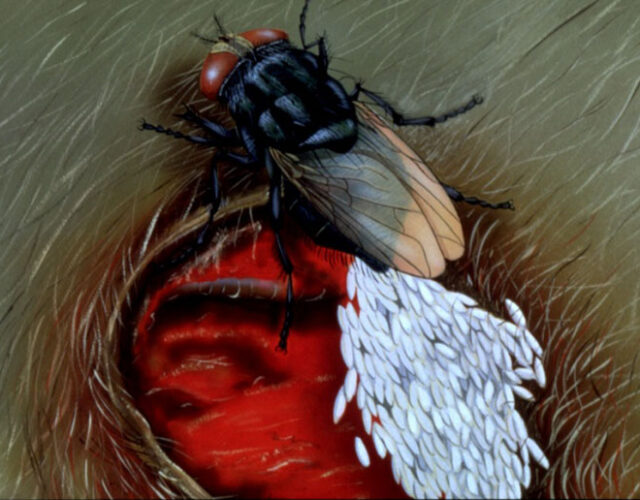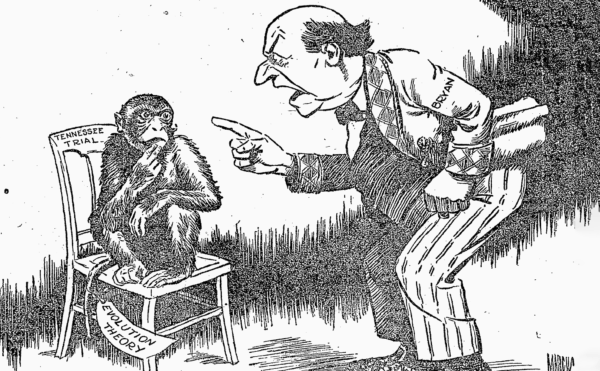How the most revolting parasite on earth—the vile screwworm—inspired a revolution in how we eradicate menacing diseases.
About The Disappearing Spoon
The Science History Institute has teamed up with New York Times best-selling author Sam Kean to bring a second history of science podcast to our listeners. The Disappearing Spoon tells little-known stories from our scientific past—from the shocking way the smallpox vaccine was transported around the world to why we don’t have a birth control pill for men. These topsy-turvy science tales, some of which have never made it into history books, are surprisingly powerful and insightful.
Credits
Host: Sam Kean
Senior Producer: Mariel Carr
Producer: Rigoberto Hernandez
Associate Producer: Padmini Raghunath
Audio Engineer: Jonathan Pfeffer
Transcript
Farm life is always hard, but young Edward Knipling had it worse than most kids.
Knipling grew up in southern Texas in the 1910s, and his family was too poor to afford veterinary service. So the worst job on the farm fell to him: picking screwworms out of open wounds on cows.
Now, the name “screwworm” is a slight misnomer. As adults, they’re actually flies. They look like houseflies, with metallic-green bodies and orange heads.
But before turning into adult flies, screwworms do have a worm-slash-maggot phase—and it’s utterly disgusting. These maggots will infiltrate any wound on any animal—even tiny mosquito bites. And once inside, they’ll start devouring its flesh, turning tiny wounds into huge dripping ulcers.
So imagine little Edward Knipling, picking maggots out of these wounds by hand before they killed the family cows. Understandably, this produced a lifelong hatred of screwworms in him.
Now, Knipling did not hate all bugs. Far from it. He eventually became an entomologist, and even named his pet Siamese cats after insects. One was named Anthonomus <“an-THON-uh-muss”> after a weevil, and one named Culex <“KYU-lex”> after a mosquito.
But screwworms? Screw screwworms: he hated those vile little things. So when Knipling landed a job at a small, rundown U.S. Department of Agriculture lab in Texas, he decided to study screwworms in detail—looking for any weakness that could destroy them.
It took a while. But in 1937, he finally found something—or at least he thought so.
It turns out that screwworm flies have an unusual mating system. Male flies mate promiscuously, with a up to dozen females if they can. But female flies are picky. Females have sex once, and then never again, even if they don’t get pregnant.
Now, to most people, this would probably seem like a useless fact. Who cares? But that’s what separates Edward Knipling from most people. His intuition told him this fact was vital—somehow. He started wracking his brains, turning the idea this way and that. How could it help him eradicate screwworms?
The plan he came up with was later called, by no less than the New York Times, quote, “the single most original idea of the 20th century.” Now, that might seem like hyperbole. After all, we did get computers and airplanes last century, too.
But after learning more, I don’t think it’s crazy hyperbole. I think you can make a case that what Edward Knipling envisioned just might be one of the more revolutionary ideas of the past hundred years.
I’d like to thank listener Barbara Haffner for suggesting today’s topic. Although, ha, I guess I should blame her as well, for all the heebie-jeebies I suffered when reading about screwworms. Now, I say that jokingly, of course. But I’m not exaggerating when I say how disgusting screwworms are.
Screwworm flies lay eggs on any open wound, which again, can turn even tiny mosquito bites into gaping, pulsating sores—sores filled with thousands of wriggling maggots.
But if that isn’t bad enough, screwworms also lay eggs on mucus membranes. Eyes, lips, anus, vagina. Monkeys in Panama sometimes tumbled out of trees after screwworms ate their eyeballs out. Screwworms also burrow into the belly buttons of newborn baby deer and eat their flesh from the inside.
And if that still isn’t disgusting enough, well, screwworms also infect human beings. I will spare you the worst details of where. But seriously, I have seen some vile pictures. They’re one of the worst parasites on Earth.
So you can imagine why Edward Knipling was determined to eradicate them. Knipling was a tight-mouthed man with thin brown hair and dark, intense eyes—boring right into you, kind of like screwworms did. And in 1937, the solution to eradicating screwworms suddenly came to him—the big leap that carved his name into science history.
Again, the key fact was this: male flies mate multiple times, while female flies just once. So Knipling came up with a plan. What if he could mass-produce sterile male flies in the lab, then release them into the wild?
Now, this might sound backwards. He’s going to eradicate screwworms by…releasing more of them? But remember, adult flies don’t feast on animals—only young maggots do. And after a few weeks, those sterile flies he released would die of old age, since flies have short lifespans.
And here’s the benefit: If you release sterile males, some of them will mate with fertile females, perhaps several fertile females. And because females mate just once, those females will never have viable eggs now. You’ve effectively sterilized them, too. They’ll never reproduce, and overall population numbers will drop.
Now of course, there would still be fertile wild males out there to mate with other females. So this wouldn’t eliminate screwworms in one swoop. But Knipling reasoned that if he kept releasing swarms of sterile males, over and over, he could drop the population number more and more each round. Eventually, it would reach zero.
It was a war of attrition—one that used no noxious chemicals or insecticides. And best of all, after he released them, the flies would do all the work. He was essentially harnessing the natural drive to reproduce to make screwworms screw themselves.
Unfortunately, right after his epiphany, Knipling got diverted into other work. This was during the Great Depression. People were already starving, and there were outbreaks of agricultural pests in Illinois and Iowa. Then World War Two erupted, and he got roped into fighting disease-carrying lice and mosquitos abroad.
Meanwhile, he also needed a way to actually sterilize the screwworm flies. At first his team tried spraying them with noxious chemicals. But they couldn’t find one that rendered them sterile. And again, Knipling wanted to avoid poisonous chemicals. But how else to sterilize them?
The answer finally came to him in 1950. He was reading a magazine story, which mentioned that exposure to x-rays can cause sterility. So perhaps x-rays could sterilize screwworms. It seemed worth a shot.
The only problem was, Knipling still worked at the lowly U.S. Department of Agriculture lab. They didn’t have a fancy x-ray machine, nor the money to buy one. He couldn’t just request funds from Congress, either. Oh, no. In fact, Knipling lived in terror of Congress ever finding out about his work.
You see, as a USDA researcher, he was spending taxpayer dollars. And just like nowadays, know-nothing members of Congress absolutely loved to pounce on pointy-headed scientists who they assumed were wasting government cash.
Knipling’s work seemed especially ripe for ridicule. What kind of pervert studies screwworm sex? It was practically un-American.
So beyond his lab, Knipling had to keep mum about his research—no funding requests. Thankfully, a colleague named Raymond Bushland knew some x-ray technicians a hospital on a military base near San Antonio. So Bushland suggested sneaking some flies into the hospital when no one was around.
Now, this was kind of a nutty idea. Military bases aren’t exactly wild about people sneaking onto them. Especially into hospitals with wounded veterans. And double especially with parasites that feast on open wounds.
But Knipling was determined. He agreed to the smuggling operation.
Sadly, the details of this caper have been lost to history. But I imagine Knipling duct-taping boxes of screwworms to his body under his shirt. Then sneaking into the hospital’s loading dock, and darting from doorway to doorway down empty corridors. Very Ocean’s 11.
Regardless, he got the screwworms inside. And over a few weeks, he and his team zapped them at various stages of their lifecycle. The results were encouraging. If they zapped the flies during their teenage, or pupal phase, the flies would grow into adults who were capable of mating, but lacked a functioning gonads. Perfect sterility.
At this point, Knipling was beyond excited. His dream of eradicating screwworms was within his grasp. He just needed to confirm things with a real-world test.
He finally got the chance in 1951. And it turned out to be a complete flop.
In 1951, Knipling ran his first real-world experiment with sterile flies, on Sanibel Island off Florida. Deer there kept getting infected, and the island was small and obscure, perfect for a clandestine test.
To deploy the flies, scientists dropped them from airplanes in cardboard boxes. The boxes were refrigerated beforehand to keep the flies sluggish. But as soon as they hit that warm Florida air, they sprang awake and zipped off to mate with fertile females—and hopefully crash the screwworm population.
But the experiment simply didn’t work. The population sank a little, but never dropped to zero, despite months of labor. As for why things failed, Knipling didn’t know. Maybe they hadn’t bombarded the island with enough sterile flies. Or maybe fertile screwworms were flying over from the mainland a few miles away.
The only thing Kipling did know was that he’d failed—and that he was happy he’d kept his mouth shut. He didn’t need Congress knowing that the screwworm sex guy couldn’t even run a proper experiment.
Thankfully, Knipling got a second chance. In 1954 an outbreak of screwworms began ravaging the island of Curaçao <COOR-uh-sow> off Venezuela. Goats there were dropping like, well, flies, and farmers faced starvation. So a desperate official there wrote to Knipling. He didn’t know about the sterility experiments. He just knew that Knipling was a screwworm expert, and he begged for help.
Now, Knipling had no idea where Curaçao was; he had to pull down an atlas to look it up. It lay twenty miles north of Venezuela, which was good. Flies couldn’t zip up from the mainland and reinfect the place. Equally good, it was far from the United States and its penny-pinching Congress-critters. Totally under the radar.
Knipling and his team began drawing up plans. This time, they wanted to make sure they released enough flies. So they basically set up an industrial factory for mass-producing flies—which was every bit as disgusting as it sounds.
It opened in March 1954. Inside the factory, there were whole troughs of writhing maggots just lying around. And they fed the maggots with a slurry that Raymond Bushland invented: raw hamburger soaked in blood and formaldehyde—forty tons every week. Imagine the stench. But the flies thrived, and the factory churned out 170,000 sterile flies per week, then released them into the wild.
This time—the results were stunning. The screwworm population collapsed, and within nine months, Curaçao was screwworm free. Best of all, the project cost just $20,000, and used zero insecticides.
Pretty soon Knipling felt confident enough to go public with his ideas. And he had good timing in doing so. Screwworms were overrunning several Southern states by then, devastating whole herds of cattle, plus wildlife. Ranchers were desperate for help—so much so that even the know-nothings in Congress swallowed hard and gave the screwworm sex guy some cash.
Given how vast the U.S. was compared to Curaçao, Kipling’s team had to build an even bigger facility for mass-producing sterile flies—a whopping 200 million every week. Imagine all the raw hamburger.
Then they’d load the sterile flies onto airplanes for deployment. Reportedly the boxes of flies smelled so bad that some pilots refused to take them as cargo. The scientists took to buying cologne in bulk to spray the boxes down.
But once the odor problem was solved, the eradication campaign soared. By 1966, screwworms had been completely eliminated in the United States.
And scientists weren’t done there. In the 1970s and 1980s, they devised a wildly ambitious plan to push the screwworm all the way down to Panama, and eliminate it from North America entirely. This plan took place against the backdrop of some serious turmoil in Central America—guerilla battles and coups and insurrections. I’ve actually put together a little bonus episode about this at patreon.com/disappearingspoon. Check it out—it’s a fascinating story.
But suffice it to say that the United States remains screwworm free today. And given that success, you might be wondering, Why haven’t scientists used this sterile-insect method against other insects?
And the answer is, they have. It’s helped fight agricultural pests like melon flies and onion flies and bollworms. Most importantly, it’s helped combat the tsetse <tSET-zee> fly, a bloodsucking critter that transmits diseases in Africa.
Then there’s mosquitos—the deadliest animal on earth, responsible for spreading malaria and yellow fever and all sorts of terrible things. Just like screwworm flies, most female mosquitos mate just once. So mosquitos seem perfect for the Knipling sterility treatment.
Unfortunately, there’s a problem here. I mentioned before that Knipling’s original idea was to sterilize and release male flies. Releasing sterile females doesn’t help, since they don’t mate with other females. In fact, releasing sterile females works against you, since sterile males might waste time and energy mating with them, and thereby miss opportunities with fertile females.
But that brings up a huge problem—separating the boys from the girls. How on earth do you determine the sex of itty-bitty mosquito eggs?
Knipling and his colleagues had ideas. Males and females have different body structures, and therefore different densities. So maybe they could float male eggs in water, or centrifuge eggs to separate the sexes.
But those ideas turned out to be impractical. It’s just too much work to separate male screwworms from females. So most programs sterilize them all and release both. It’s not optimally efficient, but the sterile females don’t do active harm, so it’s not a huge deal.
Unfortunately, mosquitos aren’t so forgiving. In mosquitos, only the females bite animals for blood and spread diseases. So if you ran the Kipling sterilization process, and released some sterile females, you might actually increase the spread of disease. Bad idea. So the Knipling process has been a non-starter there.
But there is hope. I mentioned tsetse flies a moment ago. In that species scientists have found ways to quickly sort males from females, by shining light through the eggs. In theory, you could then zap the females with lasers or whatever. So maybe some smart young listener of this podcast will figure out a way to do something similar with mosquitos, making the Knipling treatment viable.
Or if you want to get a little sci-fi, we might even take Kipling’s general idea in a whole new direction, using CRISPR and so-called gene drives. There are more details about this in the bonus episode.
But the larger point is this. Knipling’s basic insight was to create a variant of a species in the lab; release it; then turn the mating instinct of animals against themselves. And if we can somehow do that to fight mosquitos—either by quickly separating males from females, or by harnessing gene drives—then we might be able to wipe out malaria and other diseases the same way we wiped out disgusting screwworms.
And in my book, freeing human beings from the misery of those ancient diseases would be right up there with computers and airplanes. A hundred years from now, the Knipling technique really might seem like the best idea of the twentieth century.




